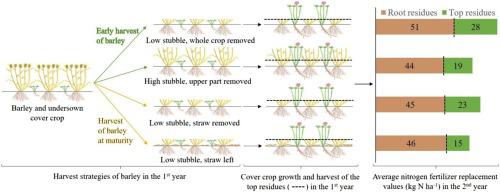当前位置:
X-MOL 学术
›
Eur. J. Agron.
›
论文详情
Our official English website, www.x-mol.net, welcomes your
feedback! (Note: you will need to create a separate account there.)
Cover crop and cereal straw management influence the residual nitrogen effect
European Journal of Agronomy ( IF 4.5 ) Pub Date : 2020-08-01 , DOI: 10.1016/j.eja.2020.126100 Doline Fontaine , Jørgen Eriksen , Peter Sørensen
European Journal of Agronomy ( IF 4.5 ) Pub Date : 2020-08-01 , DOI: 10.1016/j.eja.2020.126100 Doline Fontaine , Jørgen Eriksen , Peter Sørensen

|
Abstract Cover crops (CC) may play an essential role in the recycling of nutrients in organic farming systems with cereals. Harvest time of cereals and management of straw in the field can affect the growth of CC and subsequent nitrogen (N) fertiliser replacement value (NFRV) in the following crop. This study investigates 1) the effect of harvest time, 2) cutting height of straw and 3) straw removal from the main crop on CC growth, composition, uptake and NFRV in the following crop and 4) the effect of CC harvest in autumn on the NFRV in the succeeding crop. A CC mixture of mainly red clover, with chicory and ryegrass was sown under a spring barley crop in 2017, and replicated in 2018. Four strategies of barley harvest were conducted: 1) early harvest as whole crop or 2) early harvest of the upper parts only, 3) at maturity with straw removed or 4) at maturity with straw left on the field surface. Subsequently, CC and high stubbles of left straw were harvested and removed in autumn in half of the field replicates. The residual effect was measured in spring barley in the succeeding year. The CC aboveground biomass dominated by the clover had an N uptake for both years of 40−77 kg N ha−1. Variability was significant between years but not caused by the harvest time or by straw management. In the succeeding year, residues from barley and CC could replace 61−85 kg N ha−1 of mineral N fertiliser, which were mostly derived from CC roots and stubble. High straw stubble left (40 cm length) significantly reduced the NFRV of CC shoots by 20%. Root residues (including barley and CC roots) contributed a substantial N supply to the following crop irrespective of aboveground CC biomass. The availability of N derived from CC shoot mineralisation differed significantly in the two years and was also influenced by straw left from the previous crop.
中文翻译:

覆盖作物和谷类秸秆管理影响残氮效应
摘要 覆盖作物 (CC) 可能在谷物有机农业系统中养分循环中发挥重要作用。谷物的收获时间和田间秸秆的管理会影响后续作物中 CC 的生长和随后的氮 (N) 肥料替代值 (NFRV)。本研究调查了 1) 收获时间的影响,2) 秸秆切割高度和 3) 从主要作物中去除秸秆对后续作物 CC 生长、成分、吸收和 NFRV 的影响,以及 4) 秋季收获 CC 的影响下一季作物中的 NFRV。2017 年在春大麦作物下播种了主要由红三叶草、菊苣和黑麦草组成的 CC 混合物,并于 2018 年进行了复制。实施了四种大麦收获策略:1) 早收整季作物或 2) 早收上部作物仅零件,3) 成熟时除去稻草或 4) 成熟时稻草留在地表上。随后,在一半的大田重复中,在秋季收获并去除 CC 和高残茬。在接下来的一年中测量了春大麦的剩余效应。以三叶草为主的 CC 地上生物量在这两个年份的 N 吸收量为 40-77 kg N ha-1。年份之间的差异很大,但不是由收获时间或秸秆管理造成的。在接下来的一年中,大麦和 CC 的残留物可以替代 61-85 kg N ha-1 的矿物氮肥,这些肥料主要来自 CC 根和茬。留下的高秸秆残茬(40 厘米长)显着降低了 CC 枝条的 NFRV 20%。无论地上的 CC 生物量如何,根残渣(包括大麦和 CC 根)都为后续作物提供了大量的 N 供应。来自 CC 枝条矿化的 N 的可用性在两年内有显着差异,并且还受到前一作物留下的秸秆的影响。
更新日期:2020-08-01
中文翻译:

覆盖作物和谷类秸秆管理影响残氮效应
摘要 覆盖作物 (CC) 可能在谷物有机农业系统中养分循环中发挥重要作用。谷物的收获时间和田间秸秆的管理会影响后续作物中 CC 的生长和随后的氮 (N) 肥料替代值 (NFRV)。本研究调查了 1) 收获时间的影响,2) 秸秆切割高度和 3) 从主要作物中去除秸秆对后续作物 CC 生长、成分、吸收和 NFRV 的影响,以及 4) 秋季收获 CC 的影响下一季作物中的 NFRV。2017 年在春大麦作物下播种了主要由红三叶草、菊苣和黑麦草组成的 CC 混合物,并于 2018 年进行了复制。实施了四种大麦收获策略:1) 早收整季作物或 2) 早收上部作物仅零件,3) 成熟时除去稻草或 4) 成熟时稻草留在地表上。随后,在一半的大田重复中,在秋季收获并去除 CC 和高残茬。在接下来的一年中测量了春大麦的剩余效应。以三叶草为主的 CC 地上生物量在这两个年份的 N 吸收量为 40-77 kg N ha-1。年份之间的差异很大,但不是由收获时间或秸秆管理造成的。在接下来的一年中,大麦和 CC 的残留物可以替代 61-85 kg N ha-1 的矿物氮肥,这些肥料主要来自 CC 根和茬。留下的高秸秆残茬(40 厘米长)显着降低了 CC 枝条的 NFRV 20%。无论地上的 CC 生物量如何,根残渣(包括大麦和 CC 根)都为后续作物提供了大量的 N 供应。来自 CC 枝条矿化的 N 的可用性在两年内有显着差异,并且还受到前一作物留下的秸秆的影响。











































 京公网安备 11010802027423号
京公网安备 11010802027423号